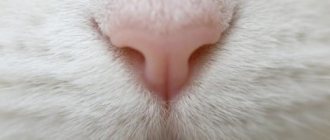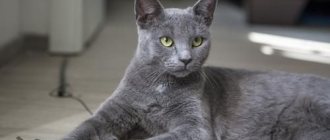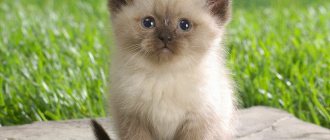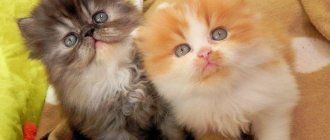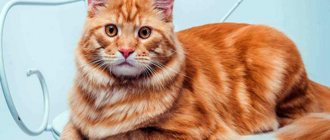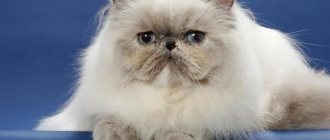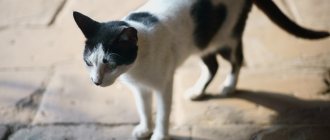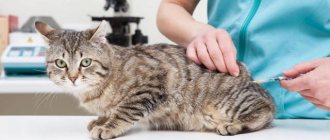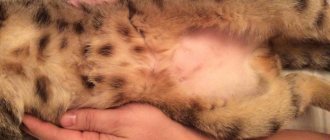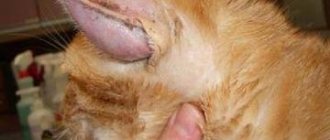The structure of a cat's paws
The light, dancing gait of cats cannot fail to attract attention. Take a closer look: they walk on their toes, like ballerinas! The cat does not step on its heel when walking, the paw remains collected and rounded, and the sharp claws are securely hidden in special “cases.”
The paw is designed in such a way that every finger and every claw is reliably protected. Between the toes, much coarser hair grows than throughout the animal’s entire body, and the base of the toes is protected by elastic, hairless pads.
Nature has reliably protected cat fingers and claws
Cat's paws are perfection conceived and realized by nature and deserve a separate story. All joints and joints are endowed with extraordinary mobility, which not only ensures graceful movements, but also allows, if necessary, to run very quickly, jump high and far, and perform unimaginable somersaults and pirouettes. The motor reactions of this animal are faster and more accurate than those of any mammal.
Flexible and tenacious fingers allow cats to move on any surface
Fingers are especially flexible - each of them seems to live a separate life, moving, bending and unbending independently of all the others. Thanks to this, cats instantly find balance and stay on almost vertical, uneven, slippery, very risky surfaces.
The cat puts its paw on its toes, the heel remains high above the ground
The famous cat toe-walking is complemented by another gait feature called ambling. All cats are pacers: they alternately move all their right paws, and then the two left ones. This allows predators to confuse their tracks, for secret purposes accurately placing one fingerprint on another. In addition, ambling makes the cat more stable and maneuverable - it makes it possible to quickly develop speed and change the direction of movement.
The pacer cats can walk, accurately following the trail.
Infrequently, but such a congenital pathology as shortened toes on the front or hind legs still occurs. An animal with such an anomaly cannot fully move; in the wild or on the street it will inevitably die. A domestic kitten with underdeveloped toes usually adapts to walking on its own, albeit slowly, with its paws tucked under it. Such individuals, of course, should not give birth to offspring - it is better to sterilize them in a timely manner.
The fingers and claws on the front paws of all cats are designed to catch and hold prey - they are much weaker than the striking hind limbs. However, large predators are capable of inflicting significant damage on their prey with a powerful blow from their front paw. By the way, have you noticed which “hand” your cat uses more actively?
In a fight, all four paws are used - but the back ones are much more dangerous
It turns out that the cat family also has its own right-handers and left-handers. Moreover, cats often prefer the left paw, and males - the right. Accordingly, it is on these “priority” paws that the toes of animals are more developed.
Height or length?
Our smaller brothers walk on four legs, which creates some confusion when taking measurements. What is the difference between a pet's height and its body length?
A cat's height is measured vertically. The withers are taken as the starting point - the border between the cervical and dorsal spine, the highest part of the back. The center of the withers is located at the point between the shoulder blades of the front legs; this place is covered by a particularly dense fold of skin. The cat holds the cat by the withers (in common parlance, by the scruff of the neck) during mating, and the cat drags the newborn kittens.
As for body length, its value is measured in the horizontal direction.
Let's start taking measurements
Measuring the height of a cat is more difficult than measuring the height of a dog. A standard cat will not stand in one place for even a couple of minutes, so to take measurements you will need an assistant to hold the fidget.
The rest is a matter of technique. Place the cat close to the door frame or wall, level with the height of the withers, leave a mark with chalk, and then measure the distance from the floor to the mark made.
Another option is to use a measuring tape. To do this, apply the tape measure itself to the withers, and lower the end of the measuring tape to the floor surface. The resulting value is the height of the animal. If the cat is long-haired, spread the fur to the cat before measuring.
What to do if your pet desperately does not want to stand still for at least a minute, and there is no assistant nearby? Then you can use a trick and measure the animal’s height from a lying position.
If the apartment windows face the sunny side, place a sheet of Whatman paper on the windowsill and let the cat lie down in a place warmed by the sun. When your pet falls asleep, straighten his paws vertically in relation to his body and place marks on the paper. However, when choosing this method, the measurement error increases noticeably.
What about the length?
Along with the height of the animal at the withers, the breed standards must indicate the length of its body. So in our story it would be unfair to ignore this parameter.
Sometimes it is believed that the length of a pet’s body is measured from the tip of the nose to the tip of the tail. However, in fact, the length of a cat with a tail does not say anything about its size, so measurements are taken without taking into account the tail. Even more precisely, the length of the animal’s body is measured from the base of the neck, level with the shoulder joints, to the base of the tail. The measuring tool is the same measuring tape.
Interestingly, data on body length allows us to determine the approximate age of the animal. Here are some approximate indicators for a medium-sized animal:
- newborn kitten – 12 cm;
- kitten aged 2 months – up to 24 cm;
- kitten aged 5-6 months – up to 35 cm;
- adult cat – up to 35 cm;
- adult cat – up to 37 cm.
How many fingers does a cat have?
Only an ignorant person can think that a cat, like him, has two dozen fingers on its “hands and feet.” Nothing of the kind - count for yourself: on each of the cat's front paws there are five fingers (four main and one dewclaw), and on the back paws there are only four fingers. The dewclaw (or false) finger is located separately on the front paw, just above the metacarpus, and is used only on inclined or vertical surfaces.
That is, the total number of fingers is eighteen - two less than the vast majority of other animals. But this is if we talk about ordinary cats. But there are also extraordinary ones - we will talk about them a little later.
An ordinary cat has four primary toes and one dewclaw on its front paw.
Were there any profits?
It is obvious that at the dawn of the glorious cat family, they, like all mammals, had five fingers on all four limbs. However, the cat led such a lifestyle that the fifth toe on its hind legs was not only not used, but also got in the way, which is why it began to gradually disappear in the process of development.
The front paws are a completely different matter. Although dewclaws stand apart from everyone else here, sometimes they help their owner a lot - for example, without them it would be much more inconvenient to climb trees.
If on the front paws the dewclaw is clearly visible, then on the hind paws there is no trace of it left.
If we draw an analogy with dogs, then puppies are often born with underdeveloped false toes on their hind legs. To avoid injury, they are removed for babies in the first days or even the first hours of life. The only exceptions are some breeds where the hindquarters are a sign of the standard (for example, Briards and Pyrenean Mastiffs).
In cats, evolution has advanced further, and such a rudimentary manifestation is almost never observed in newborn kittens. On the metatarsal bones of the hind limbs, only a barely noticeable hint of the fifth toe remained.
Why does a cat sharpen its claws?
Why a cat sharpens or chews its claws is of interest to many owners of tailed pets. In addition to sharpening its weapons, the cat sharpens keratinized processes due to discomfort. Thus, dead particles of claws cause inconvenience to the cat in the process of retracting them into the pad. The pet begins to get nervous and tries to bite off or grind off the interfering layer.
Find out also about cat declawing>>>
This is what most often provokes the animal to tear up the sofa, curtains or other suitable surfaces. It is almost impossible to avoid this, so it is recommended to first purchase a special scratching post and accustom the animal to it. The cat will know the right place where it can easily sharpen and put its defense weapon in order.
If a cat chews its claws, or lets them into the owner’s body while lying on its knees, it should not be scolded under any circumstances. Thus, the animal leaves its specific secret on its beloved owner, indicating to other animals that the owner is busy.
Another reason that a cat begins to “sharpen” its claws on its owner is the so-called milk step. This phenomenon is caused by reflexes from childhood. At an early age, kittens intensively knead their mother's belly with their paws and thus stimulate the flow of milk. Not wanting to receive such affection from a mustachioed pet, veterinarians recommend regular trimming of cats' claws or purchasing special caps for the claws.
What is polydactyly
The standards for the vast majority of domestic breeds call the general norm for a cat to have eighteen toes. But there are exceptions to the usual rules - cats with many toes. Denoting a fairly common genetic mutation, the word “polydactylism” consists of two Greek words: “poly” is translated as “many”, and “dactylos” is translated as “fingers”; This phenomenon is also called hyperdactyly. With polydactyly, one paw can have up to seven toes, and sometimes even more.
Polydactyly in cats is a harmless but very unusual mutation.
Most often, the mutation appears on the front legs, somewhat less often - on all four limbs, and most rarely - exclusively on the back legs of the cat.
Polydactyly is inherent in almost all animals and even humans, but in the cat family this strange phenomenon occurs most often. If one of the parents is polydactyl, then the probability of giving birth to “polydactyl” kittens reaches sixty percent.
Postaxial polydactyly makes a cat's paws stable in the snow
There are two known varieties of feline polydactyly, which in the slang of felinologists are called “mittens” and “snowmobiles”. Postaxial polydactyly - when additional fingers are aligned with the main ones. This helps the animal easily move through deep snow without falling into it - that’s why these cat paws are called snowmobiles. And with preaxial polydactyly, the extra fingers grow as if separately from the rest. At the same time, the cat's paw really resembles a funny mitten.
Preaxial polydactyly - these paws really look like mittens
There are also examples of “reverse” mutation - hypodactyly, which, unfortunately, is not as harmless as polydactyly. Kittens that at birth had fewer than the standard eighteen fingers rarely survive to adulthood: they usually have pathologies or severe underdevelopment of the liver. The gene mutation that causes hypodactyly activates the so-called “junk” genes, which provoke the development of dangerous pathologies in the cat.
Video: polydact - a cat in mittens
Extra fingers - where and why?
Multi-toed cats have been known for a very long time - they live with humans for as long as our domesticated feline community has existed. According to the scientific definition of geneticists, manifestations of polydactylism are inherited as an autosomal dominant trait of the Pd gene with incomplete penetrance.
Does this cause discomfort to the cat? Judging by appearance alone, one would think that polydactic cats must have a very difficult time moving around. In fact, this is completely wrong. Since the anomaly is congenital, the “special” kitten perceives it as a completely natural state of affairs and does not spend any effort to adapt. True, breeders note that such babies take a little longer to learn to walk than their usual 18-toed littermates.
Multi-toed kittens start walking a little later than their “standard” littermates.
The paws of such animals are much more stable when walking on various difficult surfaces, and when hunting, a couple of additional claws are never superfluous. According to an old legend, in difficult times of hunger, multi-toed Maine Coons even learned to catch fish in order to give it to their owners for food.
Video: the more fingers, the more convenient it is to play
Record holders for the number of fingers
It is difficult to name a clear record holder for polydactylism. Recently, the popularity of polydact cats has been growing rapidly throughout the world, and there are quite a few examples of individuals with seven toes on each paw. According to some reports, there was a Mickey Mouse cat whose total number of fingers reached 32 - it was reported back in 1974, but there is no official confirmation of this phenomenon.
Sometimes polydactyly is confused with another congenital mutation - polymelia, in which additional fingers appear due to an extra limb fused to the main one. Most likely, the cat Mickey Mouse had just such a pathology.
There are 8 toes on the paw; if everyone else has the same amount, then this cat is the undisputed record holder
Polydactyly, to one degree or another, can occur in both purebred and outbred cats. But this hereditary mutation is most often observed in breeds of North American origin - especially the multi-toed Maine Coons. It has been noticed that animals with polydactyly have more powerful bones - their chest is wider and their front legs are thicker than those of ordinary littermates.
Video: polydactyly or polymelia?
Multi-toed cat breeds
The American polydactyl cat is an indigenous North American breed, about the origin of which scientists do not have a consensus - only versions. Only the historical homeland of the American polydactyl cat is known for certain - the state of Massachusetts. Polydactyl cats, semi-wild and tame, have lived here since time immemorial and were famous for their success in catching mice.
Attempts to form a breed based on indigenous individuals began at the end of the nineteenth century, but were scattered and unsystematic. As a result, the American polydactyl cat has remained unrecognized by authoritative felinological organizations to this day.
The American Polydactyl Cat is an unrecognized breed of aboriginal origin.
Some breeders claim that forty percent of Maine Coon kittens in their catteries are born multi-toed. For a long time, such babies were discarded or sterilized, not allowed for breeding. But the breed's potential takes its toll - polydactyly is embedded in the genetics of Maine Coons.
Initially, this feature helped the native North American breed survive the harsh winter: it is easy, like on skis, to move through snowdrifts and effectively obtain food for itself. In the summer, polydactic giants successfully used their extra fingers to climb trees and catch fish.
Multi-toed paws help Maine Coons not to fall into deep snow
Recently, some mustelid nurseries have begun to purposefully breed polydacts. This bold undertaking was initiated by reputable breeders from Holland and Belgium - they are striving to recognize the multi-toed Maine Coon as a new breed, at least in experimental status at first. And recently, the American Maine Coon Breeders Association (MCBFA) developed a standard for a new breed line; Registration of polydact cats is carried out by such US felinological organizations as CFA and TICA.
Video: multi-toed Maine Coon from Omsk
The Pixie Bob (or Short Tail Elf) is the only internationally recognized breed that is officially fully polydactyly according to its standard. In the section of the breed standard that describes the pixie-bob’s paws, it literally says: “Polydactyly is allowed, with a maximum of seven toes.”
The Pixie Bob is the only breed whose standard welcomes polydactyly.
The extra toes perfectly solve the problem of evenly distributing the load on the paws, because the body of the short-tailed elf is extremely massive and muscular. Thanks to them, even the largest cats can run, jump and play with amazing ease.
Multi-toed representatives of this breed are valued several times higher than ordinary ones. Of course, there is no direct relationship between the number of toes on the paws and the price, but purebred, polydactic kittens that meet the standard can cost ten thousand dollars or even more. Multi-toed pixie bobs are also highly appreciated by experts at exhibitions.
Video: short-tailed elf with six fingers
Responsible breeding work is required to eliminate from breeding individuals suffering from radial hypoplasia, a rare anomaly that can accompany polydactyly. With this genetic disorder, the cat's paws are weakened, and the extra toes are fused, resulting in the animal being disabled.
Interesting Facts
Immediately after the discovery of America, the multi-toed cats discovered there had their eyes set on... by sailors. Thanks to them, most likely, polydacts came to Europe. Sailors believed that such cats brought good luck and were especially valued for their paws that were stable when rocking and their hunting talents - extra fingers and claws were very useful in the fight against ship rats and mice. The term “ship cats” originates from here.
A multi-toed cat on a ship brings good luck
In Medieval Europe, polydacty cats were subjected to brutal extermination during the troubled times of the “witch hunt.” Extra toes on a cat's paws were perceived by the Inquisition as a clear sign of the devil.
One of the first cats to live in the White House was Slippers, the favorite of US President Roosevelt. Slippers, who belonged to the American polydactyl breed, was distinguished by his intelligence and regal demeanor and often graced various official events with his presence. Interestingly, slippers translates from English as “slippers” - a great name for a multi-toed cat!
President Roosevelt and his beloved cat Slumpers - they have something in common, don't they?
Polydacts are sometimes called "Hemingway's cats." It turns out that the great writer Ernest Hemingway loved cats - about fifty of them lived on the territory of his estate in Key West. And the clear favorite of “old Ham” was the cat Snowball, who had six toes on each of her front paws. Now in Key West, where the writer’s house-museum is located, there are at least sixty cats and cats on board, most of them polydactics; these are the descendants of the famous Snowball.
Ernest Hemingway loved cats
Photo gallery: multi-toed cats and kittens
The Canadian polydact cat Plohish got his name for his special ingenuity in pranks.
The famous cat Tiger is a representative of the American Polydactyl breed, he has 27 fingers
Maine Coon Polydact Samba is the most famous cat of Samara
A California woman discovered a litter of multi-toed kittens in her garage.
A kitten named Wallace was dropped off at a Portland veterinary clinic.
Structure and functions of cat muscles
The entire muscular system of cats consists of more than 500 muscles, large and small, which provides them with mobility and grace. Thanks to the elasticity and complex structure of the muscles, animals can run fast and make high and long jumps.
MUSCLE STRUCTURE
Each muscle consists of two parts that perform different functions: supporting (connective tissue stroma) and working (muscle parenchyma). The stroma is more developed in muscles that bear a greater static load.
On the subject: How do veins differ from muscles?
A muscle is divided into a middle active part - the belly, consisting of muscle tissue, and a passive part - a tendon formed by dense connective tissue.
The structural and functional unit of muscle tissue is the muscle fiber (myofibra), in which the muscle contraction apparatus operates.
Muscle fiber is a cell whose length can reach 10-12 cm and thickness - 70-80 microns.
There are three different types of cells.
Fast-Twitch and Fast-Fatigue Cells - A cat's muscles are composed primarily of these cells, they provide speed and allow the cat to jump distances many times its own length. But at the same time, they quickly consume energy.
Fast Twitch and Slow Fatigue Cells - A cat has relatively few of these cells and is therefore a poor stayer. Such cells work quickly, but get tired slowly.
Slow twitch cells - These cells contract slowly and steadily. These cells work during hunting. They help the cat to move furtively, almost unnoticed, or to wait for a long time in an uncomfortable position preparing to jump.
Each muscle fiber is covered with a membrane, the sarcolemma, which includes sarcoplasm and numerous nuclei. The sarcoplasm contains organelles of the muscle cell, among which there are organelles for special purposes - myofibrils , myofibrillae. They contain the finest fibers of a protein nature - myofilaments, capable of contracting.
Thus, the muscle part has the ability to contract and relax under the influence of nerve impulses.
Groups of muscle fibers are combined into muscle bundles that form a muscle. The muscle is covered by an outer non-stretchable sheath - fascia. Fascia separates the muscle from others, prevents it from moving to the side, and protects it from unnecessary friction between each other. Fascia can cover an entire group of muscles that are functionally interconnected.
Some muscles (such as those that make up the wall of the stomach) are flat and relatively thin, others are cylindrical and thicken when they contract (for example, the biceps brachii, which flexes the elbow, or the quadriceps femoris, which is attached to the femur and extends the pelvic limb).
With the help of tendons, muscles are attached to bones. The tendon does not contract, but only transmits the action of the muscle. (however, some muscles can also attach to various organs, for example, to the eyeball; many muscles, surrounding the body cavities, protect the internal organs.)
Most muscles have one belly and two tendons and, accordingly, two points of attachment: proximal - the beginning of the muscle and distal - the attachment of the muscle.
The tendon is attached to the bone by interweaving tendon fibers with the periosteum, or the tendon fibers penetrate the bone through the periosteum in the form of Charpy fibers. The beginning of the muscle, origo , is considered to be the end attached closer to the axis of the body or the middle of the body, more proximal than the other end - the point of attachment, insertio , located distally.
As a rule, the beginning of the muscle coincides with a relatively less mobile or completely immobile part - a fixed point, punctum fixum, and with the point of attachment - a movable point, punctum mobile.
The contraction and relaxation of muscles causes the bones in the joints to move, causing them to flex, extend, and rotate inward and outward. Basically, each muscle has a pair - another muscle that performs opposite functions, thus achieving precise movements, but in general, no muscle functions on its own.
The pectoral muscles, contracting and relaxing, ensure the breathing process. The abdominal muscles help the cat defecate and give birth, as well as flex the spine when running. The pectoral limbs are attached to the body by the brachial muscles.
Each movement is to a much greater extent the result of a finely coordinated interaction of several, in most cases even many, muscles. Muscles acting in concert are called synergists ; muscles acting in opposite directions are called antagonists.
In addition to locomotor (motor) functions, muscles serve to generate heat. Heat is released when muscles tremble.
In addition to their direct responsibility to provide movement, muscles also support the skeleton in the correct position.
Each muscle has nerve endings and blood vessels. Blood supply to muscles occurs through arteries. Arteries, entering the muscles, branch to capillaries, which form a dense network in bundles of muscle fibers. Depending on certain factors, such as blood supply, muscles are dark or light in color.
Muscles are classified according to several criteria:
According to their structure, muscles are divided into striated (voluntary) and smooth (involuntary).
Striated skeletal muscle tissue consists of numerous muscle fibers, which are elongated cylindrical structures with pointed ends.
Smooth muscle tissue is one of the tissues that make up the walls of various hollow organs and is responsible for their ability to contract. It is necessary for the movement of blood through the vessels, intestinal motility, and removal of urine from the bladder.
Smooth muscles, unlike skeletal muscles, lack transverse stripes, lack tendons, and their functions are involuntary. Unlike striated muscles, smooth muscles are characterized by slow contraction, the ability to remain in a state of contraction for a long time, expending relatively little energy and without being subject to fatigue.
- lamellar (muscles of the head and body);
- long thick (on the limbs);
- sphincters (located along the edges of the holes);
- combined (composed of individual bundles, for example, muscles of the spinal column).
In addition, muscles are quadratic, mm. quadrati, triangular, mm. triangulares, circular, mm. orbiculares; muscles that have two heads (biceps) or more (triceps, quadriceps), consisting of two bellies (digastric); attached by several teeth (serratus muscles) or with the help of an aponeurosis - broad muscles, etc. (illustration below)
Depending on the size, long, wide and short muscles are distinguished.
- Long muscles are located mainly on the limbs. They have a spindle-shaped shape, and their middle part is called the abdomen, one of the ends, corresponding to the beginning of the muscle, is called the head, and the other - the tail. The tendons of the long muscles look like a narrow ribbon.
- The vastus muscles are located primarily on the torso and have an enlarged tendon called the tendon sprain, or aponeurosis.
- The short muscles are located between the ribs and vertebrae.
On the subject: Muscles go numb after cesarean
4. According to the internal structure:
- dynamic (muscles that perform a dynamic load. Dynamic muscles are characterized by a weak endomysium and long muscle bundles located along the proline axis of the muscle belly. Such muscles quickly tire.);
- static-dynamic (static function of the muscle during support, holding the joints of the animal in an extended form when standing) They have a very limited ability to shorten. Such muscles are characterized by great strength and significant endurance;
- static (muscles bearing a static load). These muscles have undergone deep restructuring and have almost completely lost muscle elements, and in some cases turned into ligament muscles
5. Depending on the action on the joint, muscles are distinguished:
- flexors (flexors);
- extensors (extensors);
- adductors (leading a part of the body to the median plane);
- abductors (retracting part of the body from the median plane);
- levators (lifters);
- depressors (lowers);
- constrictors (narrowers);
- dilators (extenders);
- sphincters (compressors);
- tensors (stressors);
- rotators (rotation function). Rotators, in turn, are divided into muscles that rotate the dorsal surface of the limb inward ( pronators ) and muscles that rotate it outward ( supinators ).
Structure of skeletal muscles
A - fusiform; B - single-pinnate; B - bipinnate; G - two-headed; D - multipinnate; E - triangular; F - digastric; Z - circular; I - a broad muscle with an aponeurosis; K - gear; L - square; M is a muscle with tendon bridges.
1 - tendon; 2 - abdomen; 3 - aponeurosis; 4 - head; 5 - tendon jumper
Fusiform muscles in which most of the muscle fibers are oriented parallel to the long axis of the muscle.
In pennate muscles, the fibers are located at an angle to the longitudinal axis on both sides of the tendon, passing through almost the entire muscle. There are many fibers in the pennate muscles, but they are short. By contracting, these muscles produce movements of great force.
If the muscle fibers are located and attached to one side of the tendon, then such a muscle is called unipennate , resembling half a feather. When the fibers adjoin both sides of the tendon shaft, the muscle is called bipennate , and multipinnate , which have a complex tendon skeleton, and the muscle fibers are attached to its numerous septa in bundles.
The orbicularis muscles are formed by fibers running in a circle, they surround the natural external openings (eye, mouth, anus, vagina) and close them during their contraction
In fan-shaped muscles, the muscle fibers run in a fan-shaped pattern. Starting from a wide area, the fibers converge in a fan-shaped manner to a narrow attachment bridge: these muscles are distinguished by great strength (for example, the temporalis muscle).
FASCIA
An important role in the structure of muscles is played by fasciae - dense fibrous membranes covering each individual muscle, group of muscles and the entire musculature. Between them, gaps with special mucus are formed, which prevents friction of muscles and ligaments. Thanks to them, with a large range of joints, the cat will not get injured.
Fascia is a tough connective tissue covering of varying thickness and strength, relatively poor in blood vessels and nerves. In most cases, they are silvery in color, shiny, and consist mainly of bundles of collagen fibers. They also always contain elastic fibers; when this type of fiber predominates, the fascia becomes yellowish in color.
Bundles of collagen fibers are connected according to the principle of a folding lattice, and at the points of attachment of the muscle to the bones, the fibers are located in the direction of the acting traction. As a rule, they are oriented obliquely to the muscle fibers passing underneath them. Compared to other pets, a cat's fascia is very thin.
Fascia forms cases for muscles or parts of muscles, connects them into groups and is partially connected with the epimysium. However, they are often themselves divided into several sheets, from which individual plates form intermuscular septa, septa intermuscularia, and can be connected to the periosteum. In other places, the fascia may be thickened and dense and serve as a retainer for the tendons, retinacula tendinum. They often attach individual muscles or even groups of muscles to bone.
The entire surface of the body is covered with two fascia. One of them is located deeper and is distinguished by the indicated properties; this is the deep fascia, fascia profunda. The superficial fascia, fascia superficialis, located closer to the surface, has a thinner structure, and it cannot be clearly demarcated in all places, since sometimes it merges with the deep fascia or passes into the subcutaneous connective tissue. In some places it includes thin flat subcutaneous muscles, mm. cutanei.
SYNOVIAL BUGS
Synovial bursae, bursae synoviales, are thin-walled isolated sacs not connected to the joint cavity. The bags are constructed from the synovial membrane and contain synovial fluid. They can be located:
- subcutaneous - subcutaneous bursa, bursa subcutanea,
- under the fascia - subfascial bursa, bursa subfascialis,
- between muscles or iodine muscle - axillary bursa, bursa submuscularis,
- under the muscle tendons is the subtendinous bursa, bursa subtendinea.
Synovial bursae reduce friction and protect the muscle from damage, thereby facilitating muscle function.
SYNOVIAL VAGINA
Each synovial sheath consists of two layers passing into one another: the outer, parietal, lamina parietalis, fused with the inner surface of the fibrous sheath, and the internal, visceral, lamina visceralis, fused with the outer sheath of the tendon, peritendineum. At the point of transition of one leaf to another, a duplication is formed, or the so-called mesentery of the tendon, mesotendinium, mesotendineum, in which vessels and nerves pass to the tendon. The sheets of the synovial sheath facing each other are smooth and lubricated by synovium, which facilitates the sliding and free movement of the tendon.
Source
How to care for cat paws
All cats instinctively take great care of their paws, and the owners’ task is to help them do this as much as possible. Even a very minor injury - a scuff, crack or scratch on the pads of the fingers can greatly unsettle your pet: he will become irritable or, conversely, depressed, and lose his appetite. In addition, wounds in this area are extremely painful, and sensitive cats suffer greatly from them.
The causes of injury to the pads of the paws and fingers can be very different:
- physical - cuts from sharp objects at home or while walking;
- thermal - cats often get burns by jumping, for example, on a hot stove, and in extreme cold, frostbite occurs on their fingers;
- chemical - if an animal walks in the snow in winter, then the substances that are sprinkled on it may cause a chemical burn on the foot;
- improper nutrition - unbalanced, poor-quality feeding leads to cracking of the skin on the pads and the appearance of weeping ulcers.
Even a minor finger injury can have serious consequences.
Some skin and internal diseases or severe stress can also negatively affect the condition of cat fingers. Such problems require diagnosis and comprehensive treatment under the supervision of a veterinarian.
To eliminate the problem, you need to identify its cause in a timely manner, and for this you should periodically carefully examine your pet’s paws. And at the slightest violation of the skin on the pads and fingers, immediately wash and heal the wounds. It is also very important to constantly monitor the condition of the claws - make sure that they do not grow too long, do not split or get injured.
Trim your cat's claws promptly
An excessively overgrown claw or neglected injuries are common causes of inflammatory processes, which in some cases can even lead to amputation of a finger.
If your cat does not wear down her claws naturally, she will need to have her nails done by herself or by a veterinarian as they grow back. To prevent your pet from damaging upholstered furniture and wallpaper with its claws, just buy him a good scratching post or make one yourself from scrap materials - it’s not difficult at all.
Buy your cat a good scratching post
In polydactic cats, the claws on the “extra” toes grow at a faster rate than on regular toes. This must be taken into account in order to adjust their length in a timely manner.
